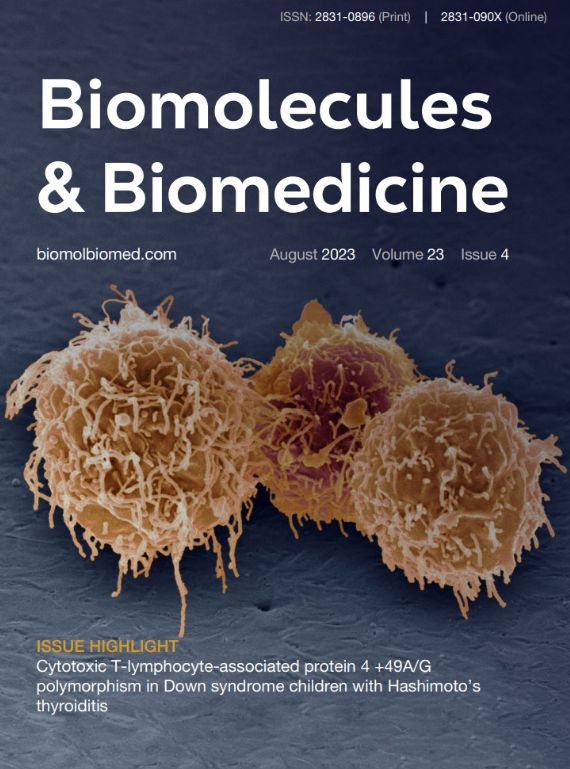Vol.23 No.2
Published: 11.07.2023.
Authors in this issue:
Abdella M Habib, Abdul-Badi Abou-Samra, Aleksandra Aracki Trenkić, Angela Pia Cazzolla, Atalla Hammouda, Benjie Xu, Boris Zec, Cheng Rao, Chenwei Li, Chunyue Feng, Dan Li, Dejan Nesic, Domenico Ciavarella, Dominik Vilímek, Dragan Stojanov, Eleonora Lo Muzio, Elina Beleva, Fang Li, Fei Liu, Feng Wang, Francesca Di Serio, Francesca Spirito, Gaofei Cao, Gordana Petrovic, Haibo Lu, Hao Jiang, Haowen Pang, Hongbing Ma, Hua Yang, Ivanka Nenova, Jan Malůš, Jaroslav Uchytil, Jianguang Shi, Jiayue Shao, Jie Gong, Jie Lian, Jieqiu Zhang, Jieyun Huang, Jin Li, Jun Wang, Justin Clark, Kai Sun, Lichun Wei, Lina Zhao, Ling-Yu Long, Lishuang Wang, Liu Shi, Lorenzo Lo Muzio, Lucia Varraso, Luigi Santacroce, Luka Nikolic, Marek Bužga, Maria Pepe, Mario Dioguardi, Matej Pekař, Mei Shi, Mengyao Zhang, Michele Di Cosola, Milica Radovanović, Milica Živanović, Miroslav Mišić, Mohan Dong, Moustapha Hamdi, Nan Xu, Omran A H Musa, Pavol Holéczy, Petr Kutáč, Qian Jiang, Qian Zhang, Qiong Qing, Quan-Bing Zhang, Ren Wang, Renato Contino, Roberto Lovero, Rui Zhang, Run Zhang, Saif Badran, Sanja Ninic, Sara Alharami, Sasa Popovic, Semir Vranic, Sergej Prijic, Shigao Huang, Shuli Tang, Siqi Liu, Snezana Ristic, Snezhana Stoencheva, Srdjan Pasic, Stasa Krasic, Suhail A Doi, Tanya Deneva, Veronika Horká, Vito Crincoli, Vladislav Vukomanovic, Vuk Milošević, Vukota Radovanović, Weijie Wu, Weiwei Li, Wen-Min Chen, Wudong Wang, Xiangyi Pang, Xiao-Jun Huang, Xiaopeng Yao, Xiaoxiao Liu, Xin Wang, Xinjian Li, Xu Wang, Xuejing Zhong, Ya-Zhen Qin, Yanhui Chen, Ying Zhang, Yingying Jin, Yongrong Zhang, Yuchen Wang, Yun Zhou, Zdeněk Švagera, Zhanet Grudeva-Popova, Zhenjing Jin, Zishan Wang,
Edited by:
Muzafer Mujic & Semir Vranic
Author guidelines
Editorial Policy
4
Issues23
ArticlesYour first address
𝐁𝐢𝐨𝐦𝐨𝐥𝐞𝐜𝐮𝐥𝐞𝐬 𝐚𝐧𝐝 𝐁𝐢𝐨𝐦𝐞𝐝𝐢𝐜𝐢𝐧𝐞 (formerly 𝐁𝐉𝐁𝐌𝐒) is the first address for discoveries in the field of biomedical research.
Become guest editor
Special Issues are led by Guest Editors who are experts in the subject and oversee the editorial process for papers.
Editor’s choice articles
The aim is to provide a snapshot of some of the most exciting work published in the various research areas of the journal.
Archive
See all
Volume 23, Issue 2, 2023
Volume 23, Issue 2, 2023
Volume 15, Issue 1,
Volume 14, Issue 1,
- All Sections
- Biochemistry
- Molecular Biology
- Pathology
- Anatomy
- Translational and Clinical Research
- New and Emerging Medical Entities
16.03.2023.
Research article
Artificial intelligence in renal pathology: Current status and future
Renal biopsy pathology is an essential gold standard for the diagnosis of most kidney diseases. With the increase in the incidence rate of kidney diseases, the lack of renal pathologists, and an imbalance in their distribution, there is an urgent need for a new renal pathological diagnosis model. Advances in artificial intelligence (AI) along with the growing digitization of pathology slides for diagnosis are promising approach to meet the demand for more accurate detection, classification, and prediction of the outcome of renal pathology. AI has contributed substantially to a variety of clinical applications, including renal pathology. Deep learning, a subfield of AI that is highly flexible and supports automatic feature extraction, is increasingly being used in multiple areas of pathology. In this narrative review, we first provide a general description of AI methods, and then discuss the current and prospective applications of AI in the field of renal pathology. Both diagnostic and predictive prognostic applications are covered, emphasizing AI in renal pathology images, predictive models, and 3D in renal pathology. Finally, we outline the challenges associated with the implementation of AI platforms in renal pathology and provide our perspective on how these platforms might change in this field.
Chunyue Feng, Fei Liu
16.03.2023.
Research article
Deletion of sphingosine kinase 2 attenuates cigarette smoke-mediated chronic obstructive pulmonary disease-like symptoms by reducing lung inflammation
Yanhui Chen, Yongrong Zhang, Cheng Rao, Jieyun Huang, Qiong Qing
16.03.2023.
Research article
Effect of vascular endothelial growth factor rs35569394 in esophageal cancer and response to chemotherapy
Zishan Wang, Chenwei Li, Xinjian Li, Jianguang Shi, Weijie Wu











